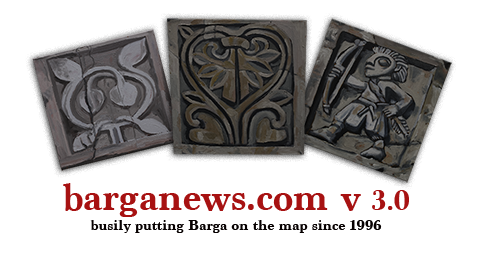Bruna Cordati Martinelli, 18th Oct 1922 – 2nd Dec 2013 was a teacher, a literary critic and author and was the daughter of the painter Bruno Cordati and lived until the last couple of days of her life in the Palazzo Cordati in Barga Vecchia, in amongst her father’s collection of paintings and art gallery.
Palazzo Cordati
Bruno Cordati bought the building in the early 1970s, but his link with the place dated back to the ’40’s, when, then recently back from Bulgaria, he rented a big room, known as the Concert Hall, and two other rooms also on the first floor, to make into his studio.
It was an important period in his artistic history, a watershed. He found himself still in the midst of war. This time not on the Front, but dramatically unfolding in his city…and then, as a refugee, in Bagni di Lucca about 15 km SE from Barga. This marked both a turning point in his life as a man, as well as in his work as an artist.
During the 40s, other families rented spaces and lived in the building. And there was a small workshop operated by a local mechanic, a busy knitter’s atelier operated by the two Pieri sisters, also housed on the first floor. Casa Cordati was a beehive of activity.
But in the last ten years of his life, Cordati could finally live and work there alone. After having restored the roof, he moved his study to the present-day exhibition galleries, and he created a comfortable apartment in his former studio.
She wrote a series of books about her life in Barga with her father – ” Il Paese di Pietra” in 2003 and ” Barga: il ricordo e il racconto” published in 2011, co written with her son Giordano Martinelli.
This week comes news of a new publication, this time in English with the title “The Painter” once again from the pen of Bruna Cordati with translation by Peter Iagnocco, a translator specialising in 20th century Italian literature – native of Australia but with Italian parents.
The Painter – Bruna Cordati
In a dark passageway of his paternal home there was a large wooden statue of St Christopher with a beard, curly hair and a carefully sculpted head but whose legs were barely intact with the feet missing and a hand that was eating away by woodworms.
His garments were stiff and over the decades, the brown dye had been repeatedly washed through the fabric to the point of hardening it.
He reproduced that dark and curly haired head with its huge black wide open eyes, making a charcoal drawing of it and then painting it in oils. He took the painting to the front hall so that his father would see it. However, if his father did see it, he didn’t say anything. He came in I’m just sat on the bench in the kitchen as he always did. The boy grabbed the painting and placed it to the side of the kitchen sink and asked in a mumbling voice “can you see it alright to like this ?” His father replied with his head facing the other way, “I’ve seen it, I’ve seen it – it is lovely”
The boy felt a burning anger rise within him and took the painting to his room and leaned it up against the wall. Beset by feelings of cold rage, he decided that he would never again speak to his father about his paintings and now upon reflection, he thought to himself that he had been faithful to that decision.
Il pittore
La giornata finiva. Già il crepuscolo invadeva le grandi stanze, si cominciava a vedere il riflesso dei lampioni dalla strada. Giù in basso, nella via di circonvallazione, le sciabolate luminose delle macchine apparivano e sparivano. Si accendevano i paesi nella massa scura delle montagne di fronte.
Cominciò a camminare su e giù per la stanza, piano, a testa bassa. C’era silenzio, avvertiva il fruscio dei grandi alberi dell’orto al poco vento della sera; la vastità stessa della casa gli allontanava i rumori, ma poi il paese d’inverno era quasi deserto. La vita rumorosa si era spostata giù in periferia dove le strade asfaltate si allargavano e crescevano come funghi ville e villini. L’erta salita per la città vecchia la difendeva in parte dall’invasione.

